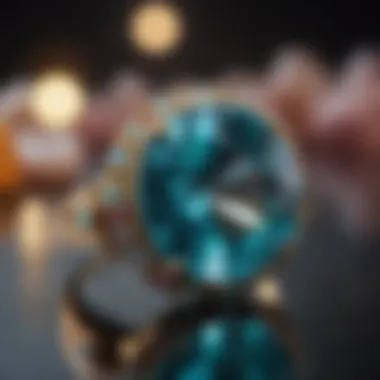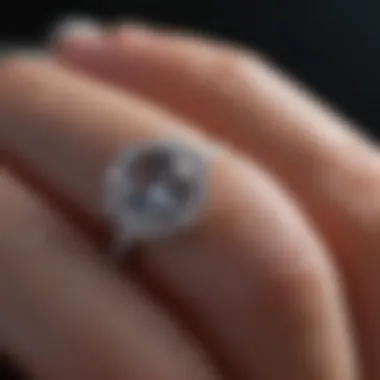Sustainable Rings in the USA: A Comprehensive Guide


Intro
Sustainable rings are gaining increasing attention in the USA and around the world. As consumers become more aware of the environmental and social impact of their purchases, the demand for ethical adornments rises. In this article, we will explore the significance of sustainable rings, examining the materials used, the brands leading the way in ethical jewelry, and the choices that promote a greener future. Here, you will find insights into how traditional jewelry production significantly affects the environment. It has prompted a shift in consumer preferences where responsible fashion choices become a priority.
Furthermore, we will discuss how to care for sustainable jewelry and its role in encouraging a sustainable lifestyle. This comprehensve guide aims to inform women of all ages about their options. Making informed choices is essential, and understanding the impact our decisions have on the planet is critical.
Understanding Sustainable Jewelry
Sustainable jewelry represents a significant shift in how we approach personal adornments. This evolving perspective not only encompasses the materials used in crafting jewelry but also addresses the broader implications related to environmental and social issues. As consumers become increasingly aware of their purchasing choices, understanding sustainable jewelry becomes essential. This comprehension empowers individuals to make informed decisions that reflect their values and priorities.
Definition of Sustainable Rings
Sustainable rings are created with a commitment to ethical practices that minimize environmental impact. These rings are often made from recycled materials, like metals and gemstones, which help to reduce the need for new mining. The definition extends beyond the choice of materials; it also includes fair labor practices throughout the supply chain. In essence, sustainable rings contribute positively to the planet and society, making them a conscientious choice for discerning consumers.
The Rise of Ethical Consumption
In recent years, there has been a significant rise in the interest of ethical consumption. This trend correlates with a growing awareness of global challenges such as climate change, poverty, and labor exploitation. Consumers now demand greater transparency from brands to understand how their products are made and where materials come from. This shift is not merely a trend; it has become a crucial part of consumer identity. People are more inclined to support businesses that align with their ethical beliefs, showcasing a preference for brands that practice sustainability.
![CDATA["As consumers become increasingly aware of their purchasing choices, understanding sustainable jewelry becomes essential."]]>
In summary, the concept of sustainable jewelry is multifaceted. It embraces a definition that encompasses eco-friendly materials, ethical labor practices, and an ongoing commitment to innovation in the industry. The rise of ethical consumption reflects a larger societal change, where individuals seek to align their purchases with their values. Thus, learning about sustainable rings is invaluable, serving both personal satisfaction and broader environmental goals.
Materials Used in Sustainable Rings
The choice of materials used in sustainable rings is critical for both environmental impact and ethical considerations. This section unfolds the various materials that are being used to create these rings, emphasizing that each element plays a pivotal role in achieving sustainability. The shift to sustainable materials not only preserves resources but also promotes innovative practices that benefit both the environment and communities involved in production.
Recycled Metals
Recycled metals stand at the forefront of sustainable jewelry production. When new rings are made from recycled gold or silver, it significantly reduces the need for mining, a process that can be highly detrimental to the environment. Mining operations can lead to habitat destruction, soil erosion, and pollution of water sources. By opting for recycled metals, jewelry makers can mitigate these impacts greatly.
Moreover, recycled metals possess the same quality and durability as newly sourced metals. They undergo a purification process that allows them to regain their integrity. Consumers can wear rings made from recycled materials without compromising on style or longevity. This practice not only benefits the planet but also encourages a circular economy, emphasizing the re-use of materials.
Lab-Created Gemstones
Lab-created gemstones represent a remarkable advancement in sustainable jewelry. These gemstones are produced in controlled environments and exhibit identical physical and chemical properties to their natural counterparts. By choosing lab-created options, consumers can avoid the ethical issues associated with traditional gemstone mining, which often involves exploitative working conditions and environmental degradation.
Additionally, lab-created gemstones typically have a lower carbon footprint compared to mined stones. The production process requires fewer resources and often uses renewable energy sources. As more consumers shift their preferences towards lab-created options, the jewelry industry is responding with diverse and beautiful collections that cater to evolving tastes.
Responsible Sourcing of Diamonds
When it comes to diamonds, responsible sourcing is an essential factor in promoting sustainability. The conventional diamond supply chain can often lead to what is known as conflict diamonds, which fund wars and human rights abuses. Hence, responsible sourcing ensures that diamonds are acquired from ethical mines or dealers that adhere to fair labor practices and environmentally friendly protocols.
Certification systems such as the Kimberley Process aim to track the origin of diamonds and certify that they are conflict-free. Consumers should seek out brands or jewelers that can provide transparency in their sourcing practices. Knowing that a diamond is ethically sourced adds significant emotional value to the purchase, transforming it into a socially responsible choice while preserving genuine human dignity.
"Using sustainable materials in jewelry production is not just about making choices; it’s about making a statement for a better future."
As this section illustrates, the materials used in sustainable rings are paramount in shaping a more responsible and ethical jewelry market. By understanding the importance of recycled metals, lab-created gemstones, and responsible sourcing of diamonds, consumers can make informed choices that align with their values and contribute to a sustainable future.
Impact of Traditional Jewelry Production


The impact of traditional jewelry production is a vital consideration in understanding the need for sustainable alternatives. This section will explore the consequences that arise from conventional manufacturing practices, focusing on both environmental and social dimensions. As consumers become more informed, the implications of jewelry's production methods come into sharp focus.
Environmental Consequences
Traditional jewelry production significantly contributes to environmental degradation. Mining for precious metals and gemstones involves extensive land disruption, leading to habitat destruction and biodiversity loss. The extraction processes often require toxic chemicals, which can pollute water sources and soil. For instance, gold mining can involve cyanide, a highly hazardous substance that can have dire consequences for local ecosystems.
Additionally, the carbon footprint associated with mining operations is profound. Energy-intensive practices and transportation add to greenhouse gas emissions, contributing to climate change. As global citizens prioritize eco-friendly practices, the environmental consequences of traditional jewelry production cannot be ignored.
"The true cost of jewelry goes beyond the price tag; it encapsulates environmental and human costs that are often unseen."
By recognizing these challenges, consumers can make more informed choices. Supporting brands that prioritize sustainable practices can lessen the environmental toll caused by jewelry production.
Social Implications
In addition to environmental concerns, traditional jewelry production raises significant social issues. Many mining operations occur in developing countries, where labor conditions can be exploitative. Workers, including many women, often endure unsafe working environments and are not compensated fairly for their labor. These social injustices underline the importance of ethical consumerism.
Moreover, traditional mining can inadvertently finance conflict in certain regions. The term "blood diamonds" exemplifies how gemstones can fund violence and human rights abuses. By choosing sustainable rings, consumers can help break this cycle of exploitation and promote fair labor practices.
However, it is important to understand that the shift towards sustainable options is not just about fostering positive social change; it also empowers communities. Responsible sourcing and fair trade agreements can provide local miners with better wages and working conditions. Engaging directly with ethical jewelry brands fosters a sense of community and supports initiatives that invest in local development.
Top Sustainable Ring Brands in the USA
When considering sustainable rings, the brands behind these products play a significant role in defining their overall impact. These companies deeply engage with ethical sourcing, innovative materials, and environmental responsibility. By highlighting top sustainable ring brands within the USA, this article aims to provide readers with trustworthy options. Supporting recognized brands that prioritize sustainability can make a positive influence on both the consumer's lifestyle and the environment. This overview will help consumers make educated choices about their jewelry purchases, as well as encourage a transition towards a more responsible fashion industry.
Brand A Overview
Brand A is known for its commitment to ethical sourcing and sustainable practices. The company primarily uses recycled metals and lab-created gemstones in their collections. This approach ensures minimal environmental impact, as repurposing existing materials reduces the demand for new mining operations.
Moreover, Brand A emphasizes the importance of transparent sourcing. Each piece of jewelry comes with detailed information about its origins and the ethical practices adhered to during production. The design aesthetic is also worth noting; Brand A offers a variety of styles, catering to different preferences while maintaining an eco-friendly approach.
Brand B Overview
Brand B has emerged as a leader in the sustainable jewelry space, focusing specifically on socially responsible production. The brand prioritizes partnerships with artisans who follow fair labor practices. By supporting local communities, Brand B ensures that their production fosters not only environmental sustainability but social equity as well.
Their product line features unique designs that incorporate eco-friendly materials. This includes lab-created diamonds and gemstones, which significantly reduce the carbon footprint compared to traditional gem mining. Those looking for distinctive yet sustainable rings may find Brand B an appealing choice.
Brand Overview
Brand C distinguishes itself through its innovative use of materials and cutting-edge design. By leveraging technology, the brand crafts rings that are not only beautiful but also environmentally friendly. Their rings are often made from both recycled materials and sustainably sourced elements.
In addition, Brand C actively engages in community initiatives aimed at promoting sustainability awareness. Each purchase contributes to environmental conservation efforts, making consumers feel empowered knowing their choices foster positive change. With a range of contemporary styles, Brand C captures the essence of modern design while upholding the principles of sustainability.
Consumer Preferences and Trends
Understanding consumer preferences and trends is crucial in the context of sustainable rings. The choices consumers make reflect their values and priorities. Increasing awareness about the impact of traditional jewelry production on the environment has led to significant changes in purchasing behaviors. More people are considering the sustainability of the products they buy. This shift encourages brands to adapt and innovate, which ultimately drives the market towards more ethical practices.
Shifts Towards Sustainability
Over recent years, there has been a notable shift towards sustainability among consumers. Many individuals now prioritize eco-friendly products over those that are not aligned with their values. This trend is influenced by several factors:
- Awareness: Access to information about environmental issues is more readily available today. Consumers are better informed about mining practices and their consequences.
- Generational Influence: Younger consumers, particularly Millennials and Gen Z, increasingly prefer brands that demonstrate commitment to sustainability.
- Social Media Impact: Platforms like Instagram amplify voices advocating for ethical consumption. Users share their experiences with sustainable brands than enhance their visibility.


These shifts indicate a growing expectation that brands integrate sustainable practices into their production processes. Consumers are now looking beyond mere aesthetics. They want to invest in jewelry with a story—a legacy of responsible sourcing and thoughtful production.
The Importance of Transparency
Transparency has become a cornerstone of trust in the jewelry industry. Consumers demand clarity about where their rings come from and the methods used in their creation. This inclination towards transparency can impact purchasing decisions for several reasons:
- Building Trust: Brands that are open about their sourcing and production processes cultivate trust among consumers. This is crucial because many people believe that transparency reflects a brand’s integrity.
- Informed Choices: When brands provide detailed information about their materials and ethical practices, consumers feel empowered to make informed decisions.
- Supporting Ethical Practices: Transparency allows consumers to support brands that adhere to sustainable and ethical standards. They can actively choose products that align with their values.
"The more transparent a brand is, the more likely consumers are to remain loyal."
Caring for Sustainable Rings
Caring for sustainable rings is essential not only to maintain their beauty but also to uphold the ethical commitment attached to them. Many people view jewelry as a long-term investment. Therefore, when you opt for a sustainable ring, it reflects your values not just in the choice of materials but also in the care you give it. Proper maintenance ensures longevity, which minimizes waste and is a crucial aspect of sustainable living. Moreover, the craftsmanship in these pieces often reflects a dedication to high-quality work, making it worth the effort to preserve them meticulously.
Proper Maintenance Techniques
Maintaining the integrity of a sustainable ring involves several practices that prevent wear and tear. Here are some techniques you can adopt:
- Regular Cleaning: Clean your ring often with warm water and mild soap. Use a soft brush to remove any dirt or oils that may accumulate. This simple routine not only keeps your jewelry looking new but also prevents damage over time.
- Inspect Settings: Regularly check the settings of stones or gems in your ring. If you notice a loose stone, take it to a jeweler as soon as possible. Timely repairs will avoid further issues down the line.
- Avoid Harsh Chemicals: Chemicals found in household cleaners can affect some metals and stones negatively. Always remove your ring when engaging in activities that involve exposure to harsh substances.
- Professional Maintenance: Consider having your sustainable ring evaluated by a professional every few years. A jeweler can provide specific maintenance suited to the materials in your piece.
Storage and Handling Tips
Proper storage and handling are fundamental to ensure your sustainable rings remain in prime condition. Here are some practical tips:
- Use Soft Pouches: Store rings in soft pouches made from fabric, avoiding direct contact with other jewelry pieces. This prevents scratches and scuffs, preserving the finish.
- Avoid Humidity: Excess moisture can cause tarnishing. It’s best to keep your rings in a dry place, preferably in a jewelry box with anti-tarnish properties.
- Remove During Physical Activities: Always take off your rings when doing strenuous activities, such as exercising or gardening. Physical stress can lead to bending or scratching, jeopardizing the integrity of the piece.
- Be Mindful of Temperature Changes: Extreme temperatures can impact certain materials. Avoid exposing your wedding band or precious rings to high-heat situations, such as saunas or hot tubs, where they may become misshapen or damaged.
"Caring for your sustainable jewelry enhances its lifespan, aligns with ethical values, and can serve as a daily reminder of nurturing the environment while expressing personal style."
In summary, caring for sustainable rings is straightforward yet critical. By adopting proper maintenance and storage techniques, you not only protect your investment but also extend the story of sustainability your jewelry represents.
Sustainable Rings as Gifts
Gifting sustainable rings is not just a fashion statement; it represents a thoughtful approach to personal adornments. This choice reflects a commitment to ethical consumption. By purchasing sustainable jewelry, individuals can promote environmental conservation and support brands that prioritize ethical practices. Gifts such as these carry a message of love and responsibility, making them particularly meaningful.
When selecting a sustainable ring as a gift, consider the value it adds to the occasion. These rings are often made from recycled materials or ethically sourced gemstones, positioning them as products that contribute positively to society. Doing so may resonate with the recipient's values and create a lasting impression.
Moreover, the act of giving sustainable rings can inspire conversations about environmental awareness. This small gesture contributes to larger conversations surrounding responsible choices in fashion, truly embodying the significance of sustainability.
Occasions for Gifting Sustainable Rings
Sustainable rings can be a wonderful gift for various occasions. Each moment offers a unique opportunity to celebrate ethical choices:
- Engagements: Choosing an ethically sourced diamond or a unique lab-created stone reflects a commitment to sustainability while marking the start of a new journey.
- Weddings: Matching wedding bands made from recycled metals can symbolize a shared dedication to sustainability in a marital partnership.
- Anniversaries: Gift a sustainable ring that signifies milestones in a relationship, continuing the legacy of love with a focus on ethical practices.
- Birthdays: Celebrate a special day with a thoughtful gift that highlights compassion towards the planet.
- Graduations: A sustainable ring can symbolize new beginnings and the achievements of the one receiving it.
Each occasion helps reinforce the value of giving sustainable gifts, encouraging friends and family to think more about their consumption habits.
Personalization Options
Personalization adds a unique touch to sustainable rings, making them even more special. Here are some ways to personalize:
- Engravings: Consider adding initials, meaningful dates, or special messages on the inside of a band.
- Custom Designs: Collaborate with designers to create a ring that reflects the recipient's style or story.
- Gemstone Selection: Let the recipient choose from ethically sourced stones, allowing them to have a hand in the creation process.
- Symbolism: Use symbols or motifs that have personal significance, such as flowers or meaningful shapes.


By personalizing sustainable rings, you deepen the emotional value of the gift. This strategy not only makes the rings more cherished but encourages a broader appreciation of sustainable practices.
Legal and Ethical Standards
Understanding the legal and ethical standards within the realm of sustainable rings is essential. These standards not only ensure consumer protection but also promote responsible practices in the jewelry industry. When purchasing a sustainable ring, knowing these key points can significantly influence your buying decision and overall impact on the environment.
Certification Organizations
Certification organizations play a vital role in validating brands that adhere to ethical practices. They provide third-party verification of a brand’s claims, ensuring that materials are sourced responsibly and that labor practices are ethical. Notable organizations include:
- Responsible Jewellery Council (RJC): Focuses on promoting ethical, social, and environmental practices throughout the jewelry supply chain.
- Fair Trade Gold: Ensures that gold is mined under fair labor conditions, directing profit back to local mining communities.
- Gemological Institute of America (GIA): Provides education and grading services to uphold quality and authenticity in gemstones.
These organizations help consumers identify jewelry made with integrity and offer assurance that they are making ethically sound decisions.
Regulations in the USA
In the USA, several regulations govern the jewelry industry to safeguard both consumers and the environment. Understanding these regulations can help consumers feel more confident in their purchases. Key regulations include:
- The Dodd-Frank Act: Enforces strict guidelines on the sourcing of conflict minerals. Jewelers are required to disclose information on the origin of materials used.
- Federal Trade Commission (FTC) Guidelines: The FTC has established rules to prevent misleading advertisements related to jewelry, ensuring that claims about materials, origins, and characteristics are factual.
- The Clean Water Act: This act regulates discharges of pollutants into U.S. waters, impacting jewelry manufacturing processes to reduce environmental harm.
These regulations are significant as they help in holding brands accountable and push for sustainable practices within the jewelry sector.
Staying informed about legal and ethical standards can empower consumers to make impactful choices that contribute positively to the environment.
The Future of Sustainable Jewelry
The future of sustainable jewelry rests on a foundation of innovation, consumer demand, and ethical practices. As society becomes increasingly aware of environmental and social issues, the jewelry industry must adapt to these changing attitudes. The push for transparency and sustainability reshapes how rings are made, marketed, and perceived. This section explores advancements in materials and the influence of consumer behavior on market trends, paving the way for a conscious approach to jewelry.
Innovations in Materials
New materials are changing the landscape of sustainable jewelry. Jewelers are now experimenting with various alternatives to traditional gemstones and metals. For instance, lab-created diamonds present an eco-friendly option that minimizes environmental harm. These diamonds are chemically identical to mined diamonds but created in controlled settings. Additionally, many brands are starting to incorporate recycled gold and silver. By using existing materials, they reduce the need for new mining operations, which are often associated with significant ecological degradation.
Another exciting development is the rise of sustainable gemstones. Design houses are now sourcing stones from ethical mines that follow stringent environmental guidelines. They are also paying close attention to the mining practices in order to respect local communities and their rights. This results in a more balanced approach that supports both the environment and local economies.
"As innovation in materials continues, customers can expect sustainable rings that are just as beautiful and unique as their mined counterparts."
Consumer Influence on Market Trends
Consumer behavior plays a crucial role in shaping the future of sustainable jewelry. Today’s buyers are more informed and conscious of how their purchasing choices impact the world. They seek transparency in sourcing and production methods. This demand for ethical practices is prompting a transformation in the industry.
Social media has amplified this trend, showcasing brands that prioritize sustainability. Platforms like Instagram and Facebook allow consumers to research brands and share their values widely. The result is an empowered consumer who can enact change through their purchases.
Furthermore, many jewelry companies now incorporate feedback from their customers into their design processes. This responsiveness leads to an increased focus on personalized sustainable options. As consumers continue to prioritize sustainability, brands are shifting to meet those needs. This shift illustrates the potential for market trends to align with ethical practices, leading to a brighter future for sustainable jewelry.
Culmination
The conclusion of this article emphasizes the critical role that sustainable rings play in the broader context of responsible consumption and the jewelry industry. Sustainable rings go beyond mere aesthetics; they serve as symbols of ethical values and environmental consciousness. As consumers become more aware of the implications of their purchasing choices, the importance of sustainable rings cannot be overstated. They offer the possibility of personal expression while aligning with one’s ethical beliefs.
Summary of Key Points
In summary, sustainable rings encompass a range of practices and materials that reflect a commitment to environmental and social responsibility. Here are the key points discussed in this article:
- Definition and Importance: Sustainable rings prioritize ecological integrity and ethical sourcing, appealing to a growing market of conscious consumers.
- Material Choices: The use of recycled metals, lab-created gemstones, and responsibly sourced diamonds reduces environmental harm and promotes sustainability.
- Impact of Traditional Practices: Conventional ring production has significant negative effects on both the environment and communities, highlighting the need for change.
- Brands and Market Trends: Numerous brands in the USA are leading this shift toward sustainability, attracting customers with transparent practices and quality products.
- Caring for Sustainable Rings: Proper maintenance and care extend the life of these rings, which aligns with the principles of sustainability.
- Legal Standards: Awareness of legal and ethical standards helps consumers make informed decisions.
- Future Outlook: Innovations and consumer influence will likely mold the future of sustainable jewelry.
Final Thoughts on Sustainable Rings
Sustainable rings are more than just fashion accessories. They symbolize a dedication to a better future through responsible production and consumption. Choosing sustainable jewelry allows individuals to reflect their values and support an industry that is shifting towards ethical practices. As sustainability continues to gain traction in various sectors, it is essential for consumers to ask questions about the origins and impacts of what they buy. This awareness fosters not only personal satisfaction but also contributes to a collective movement towards a more sustainable world. Each purchase communicates a message about priorities and values, reinforcing the idea that even small choices can have significant impacts. Advocating for sustainable rings ensures that your adornments are not just beautiful, but also aligned with a philosophy of stewardship for the planet.



